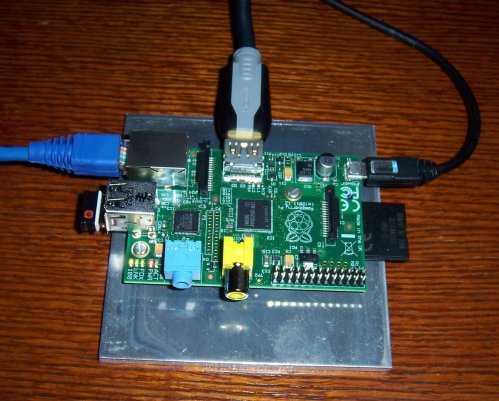
My longtime friend and collaborator Jim Strickland has had a Raspberry Pi board almost since the beginning, and he startled me by handing me one as a Christmas present. I was aware of it but hadn’t researched it deeply. Here’s a good place to start if you’re new to the concept.
Basically, it’s an ARM-6 board with HDMI and composite video output, two USB ports, and a standard RJ45 Ethernet connector. For disk it uses an SDHC card. There’s an I/O header for connecting to physical gadgets like relays and lights and things. There’s more than one OS available for it, but most people use the adaptation of Debian Wheezy called Raspbian.
I don’t like having circuit boards flopping around in mid-air, so I drilled and tapped two 4-40 holes in a husky 3/16″ aluminum plate and mounted the Pi on a pair of 3/8″ nylon standoffs.
Putting it together was a snap. I downloaded the Raspbian image file, wrote it out to a spare 8 GB SDHC card I had in the drawer with Image Writer for Windows, plugged the card into the card slot on the board, hooked up the cables, and turned it on.
Bootup isn’t snappy, and the first time in you have to set a few things like time zone, but in a couple of minutes I had Linux on my big-screen LED TV. The small black item connected to the USB port block in the photo above is the Bluetooth dongle for a Logitech wireless keyboard and mouse. This leaves me a port free for something else. Ethernet came to the device through a pair of Linksys Powerline bridges, which I’ve described here before.
I now have what Michael Abrash would call “Linux on my bedroom wall.”
This particular distro comes with Python and Scratch preinstalled, but Jim’s already gotten the ARM-6 port of FreePascal/Lazarus downloaded and running. That’s next on the list for me. I’ll wrestle with that another time, as it’s getting late here. I have a special purpose in mind for the gadget which I won’t spill just yet, since it may not be realistic. More as I learn it.










